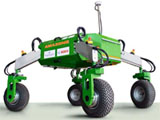Agricultural and Biological Systems Engineering, Department of

Department of Agricultural and Biological Systems Engineering: Faculty Publications
Document Type
Article
Date of this Version
2025
Citation
Computers and Electronics in Agriculture (2025) 237: 110710
Abstract
Conventional soil water balance (SWB) irrigation scheduling tools, such as FAO-56-based Spreadsheets and the Spatial Evapotranspiration Modeling Interface (SETMI), rely heavily on manual inputs and periodic field measurements, leading to delayed recommendations and missed opportunities to prevent crop stress. More critically, these tools lack the computational scalability and adaptability to leverage the high-frequency, high-volume datasets now available through modern sensing technologies. As precision irrigation increasingly depends on integrating spatially and temporally nuanced field information, there is a pressing need for decision-support systems that can process Big Data efficiently and respond in real-time. To overcome these limitations, we developed and validated a machine learning (ML) framework for near real-time prediction of soil water depletion (SWD) and site-specific irrigation recommendations in maize and soybean production systems. Unlike prior models, our approach integrates multi-source, multi-year (2020 and 2023) datasets, including remote sensing data, weather variables, soil properties, management practices, yield records, time-related features, and geospatial information, to train Decision Tree, Random Forest, Gradient Boosting, and Extreme Gradient Boosting (XGB) models. Feature selection combined agronomic domain knowledge, correlation analysis, and Random Forest feature importance to retain relevant predictors while minimizing model complexity. The SWD was typically between 0 mm (field capacity) and 110 mm (management allowable depletion with a dynamic root zone increasing up to 1000 mm for the second half of the season) for irrigated plots, and up to 180 mm in rainfed conditions. Among the models, XGB performed best in the 2024 independent validation, predicting SWD with high accuracy (maize: R2 = 0.72, RMSE = 22 mm; soybean: R2 = 0.78, RMSE = 24 mm). The average predicted SWD values were 53 mm (maize) and 54 mm (soybean), closely matching SWB Spreadsheet estimates (47 mm and 54 mm, respectively). Field deployment in 2024 demonstrated the model’s operational potential, with ML-generated irrigation recommendations (62–70 mm for maize; 73–83 mm for soybean) closely aligning with FAO-56 Spreadsheet (61 mm maize; 79 mm soybean) and SETMI (64–96 mm soybean) benchmarks. However, testing on independent 2021 data revealed reduced generalization performance, highlighting the need for more diverse training datasets. Overall, this study advances a practical, scalable, ML-driven decision support framework for real-time precision irrigation in commercial cropping systems.
Included in
Agronomy and Crop Sciences Commons, Bioresource and Agricultural Engineering Commons, Civil and Environmental Engineering Commons


Comments
Copyright 2025, the authors. Open access
License: CC BY-NC 4.0